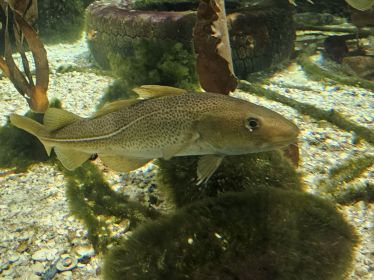- Ground sharks (Carcharhiniformes)
- Carpet sharks (Orectolobiformes)
- Stingrays (Myliobatiformes)
- Skates (Rajiformes)
- Bichir (Polypteriformes)
- Lungfish (Dipnoi)
- Gar (Lepisosteiformes)
- Eel (Anguilliformes)
- Bony-tongued fishes (Osteoglossiformes)
- Carps (Cypriniformes)
- Tetra (Characiformes)
- South American knifefish (Gymnotiformes)
- Catfish (Siluriformes)
- Salmon (Salmonidae)
- Pikes (Esociformes)
- Cod fish (Gadiformes)
- Cardinalfish (Kurtiformes)
- Gobies (Gobiiformes)
- Pipefish (Syngnathiformes)
- Gouramies (Anabantiformes)
- Flatfish (Pleuronectiformes)
- Cichlides (Cichliformes)
- Rainbowfish (Atheriniformes)
- Killifish (Cyprinodontiformes)
- Blenny (Blenniiformes)
- Wrasse (Labriformes)
- Anglerfish (Lophiiformes)
- Pufferfish (Tetraodontiformes)
- Scorpionfish (Scorpaeniformes)
- Ray-finned fish (Perciformes)
- Dragonet (Callionymiformes)
- Weever (Trachiniformes)
Atlantic cod (Gadus morhua)

Photo taken in Grenå, Denmark
The Atlantic cod (Gadus morhua) is a benthopelagic fish of the family Gadidae, widely consumed by humans. It is also commercially known as cod or codling. Dry cod may be prepared as unsalted stockfish, and as cured salt cod or clipfish.
In the western Atlantic Ocean, cod has a distribution north of Cape Hatteras, North Carolina, and around both coasts of Greenland and the Labrador Sea; in the eastern Atlantic, it is found from the Bay of Biscay north to the Arctic Ocean, including the Baltic Sea, the North Sea, Sea of the Hebrides, areas around Iceland and the Barents Sea.
The largest individual on record was 1.5 m (5 ft) long and weighed 47 kg (103 lb), but usually the cod is between 60 and 120 cm (24 and 48 in) long and weighs up to 40 kg (88 lb). Males and females are similar in size and weight.
In the western Atlantic Ocean, cod has a distribution north of Cape Hatteras, North Carolina, and around both coasts of Greenland and the Labrador Sea; in the eastern Atlantic, it is found from the Bay of Biscay north to the Arctic Ocean, including the Baltic Sea, the North Sea, Sea of the Hebrides, areas around Iceland and the Barents Sea.
The largest individual on record was 1.5 m (5 ft) long and weighed 47 kg (103 lb), but usually the cod is between 60 and 120 cm (24 and 48 in) long and weighs up to 40 kg (88 lb). Males and females are similar in size and weight.
Atlantic cod can live for 25 years, and usually attain sexual maturity between ages two and four, although cod in the northeast Arctic can take as long as eight years to mature fully. Colouring is brown or green, with spots on the dorsal side, shading to silver ventrally. A stripe along its lateral line (used to detect vibrations) is clearly visible. Its habitat ranges from the coastal shoreline down to 300 m (1,000 ft) along the continental shelf.
Atlantic cod can live for 25 years, and usually attain sexual maturity between ages two and four, although cod in the northeast Arctic can take as long as eight years to mature fully. Colouring is brown or green, with spots on the dorsal side, shading to silver ventrally. A stripe along its lateral line (used to detect vibrations) is clearly visible. Its habitat ranges from the coastal shoreline down to 300 m (1,000 ft) along the continental shelf.
Atlantic cod can live for 25 years, and usually attain sexual maturity between ages two and four, although cod in the northeast Arctic can take as long as eight years to mature fully. Colouring is brown or green, with spots on the dorsal side, shading to silver ventrally. A stripe along its lateral line (used to detect vibrations) is clearly visible. Its habitat ranges from the coastal shoreline down to 300 m (1,000 ft) along the continental shelf.
Atlantic cod can live for 25 years, and usually attain sexual maturity between ages two and four, although cod in the northeast Arctic can take as long as eight years to mature fully. Colouring is brown or green, with spots on the dorsal side, shading to silver ventrally. A stripe along its lateral line (used to detect vibrations) is clearly visible. Its habitat ranges from the coastal shoreline down to 300 m (1,000 ft) along the continental shelf.
Atlantic cod is one of the most heavily fished species. Atlantic cod was fished for a thousand years by north European fishers who followed it across the North Atlantic Ocean to North America. It supported the US and Canada fishing economy until 1992, when there was a ban on fishing cod. Several cod stocks collapsed in the 1990s (decline of more than 95% of maximum historical biomass) and have failed to fully recover even with the cessation of fishing. This absence of the apex predator has led to a trophic cascade in many areas. Many other cod stocks remain at risk. The Atlantic cod is labelled least concern on the IUCN Red List of Threatened Species.
In Aquariums and Zoos - it's a common species seen in captivity
Atlantic cod is one of the most heavily fished species. Atlantic cod was fished for a thousand years by north European fishers who followed it across the North Atlantic Ocean to North America. It supported the US and Canada fishing economy until 1992, when there was a ban on fishing cod. Several cod stocks collapsed in the 1990s (decline of more than 95% of maximum historical biomass) and have failed to fully recover even with the cessation of fishing. This absence of the apex predator has led to a trophic cascade in many areas. Many other cod stocks remain at risk. The Atlantic cod is labelled least concern on the IUCN Red List of Threatened Species.
In Aquariums and Zoos - it's a common species seen in captivity
woaqzo@yahoo.com